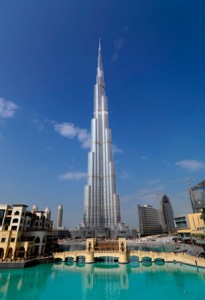Source: www.ameinfo.com
The world’s tallest tower, Burj Khalifa has finally opened its doors following five long years of construction. And, despite the last-minute name change, the presence of the world’s tallest tower will deliver direct economic benefits to the emirate of Dubai.

Emaar’s flagship project is significant in many ways. It delivers another iconic structure to Dubai’s skyline, complementing the Burj al-Arab in international recognition and plays an arguably even greater role as the anchor project to Emaar’s wider Dhs73bn ($20bn) Downtown Burj Dubai scheme.
While the emirate has suffered at the hands of the global downturn, with prices a fraction of their peak, there is confidence the scheme as a whole will recover and benefit directly from the presence of the Burj Khalifa.
Recent figures from Dubai-based Landmark Properties reveal residential sales within Downtown are currently Dhs3,500 – Dhs4,500 per square foot, and commercial property prices are between Dhs3,000 – Dhs5,000 per square foot. These prices at their peak reached Dhs13,000 per square foot and Dhs14,500 per square foot respectively. However in the last two months, according to Landmark Properties, rent rates for units in Downtown Burj Dubai rose 13%.
‘The most significant impact of the launch of Burj Khalifa will be the overall master development surrounding the tower. The launch is one large step towards the completion of the master development. Even though the final completion is not expected in the medium term, a large and functional portion of the area is completed,’ Michael Michael, director of sales and leasing with Landmark Properties told AMEinfo.com.
‘More interestingly, it also increases agglomeration economies, thus moving the market towards the creation of one primary Central Business District (CBD). In the past Dubai was developing multiple CBD’s under the free zone structure. With the consolidation of the markets, especially the commercial markets, Dubai will start to conform to more traditional urban real estate models with one primary CBD and premiums associated with the proximity to the CBD. This CBD will comprise of Downtown, DIFC, Sheikh Zayed Road (between Defence and Trade Centre Roundabouts) and, eventually, Business Bay. Gradually this agglomeration will help to stabilize the area as a whole.’
Capitalising on Downtown district
With greater stability, and a slow return of confidence to the market, Emaar is set to capitalise with a plethora of further residential and business schemes within the Downtown project. There is the nine-tower ‘The Residences’ and the Old Town which features 1,560 residential units spread across six quarters. Within the Old Town itself there are a further 405 apartments, 161 hotel rooms, 83 suites and 15 restaurants and cafes.
There are currently five hotels within the Downtown; The Address Downtown Burj Dubai, Al-Manzil, Qamardeen, The Palace and the Address Dubai Mall. Imminently, a sixth will be added when the Armani hotel opens its doors. The $750m Dubai Mall itself is another addition to a city already synonymous with retail. It features 1.1 million square metres of space with more than 1,200 stores and also contains a Gold Souk. The Old Town also features the Arabesque Souk al-Bahar, which itself features over 100 shops and 22 restaurants and cafes.
The use of an anchor project to drive investment in a particular scheme is a model that has been exploited elsewhere in the emirate and wider GCC. Notably in Saudi Arabia where the local Kingdom Holding plans to develop an $11bn mixed-use project to the north of Jeddah on the Red Sea coast, which will feature at its heart a high-rise tower reputed to reach 1 kilometre in height. It was announced in June 2009 that Kingdom Holding had selected Emaar to be the master developer of Kingdom City, which will cover 23 square kilometres and will feature the kingdom tower as a landmark.
Before the real estate crash in Dubai, beleaguered developer Nakheel had also drawn up plans for the Nakheel Harbour & Tower real estate project, which would feature a tower reputed to be the world’s tallest situated in a master planned development accommodating 50,000 people. The tower is currently on hold.














